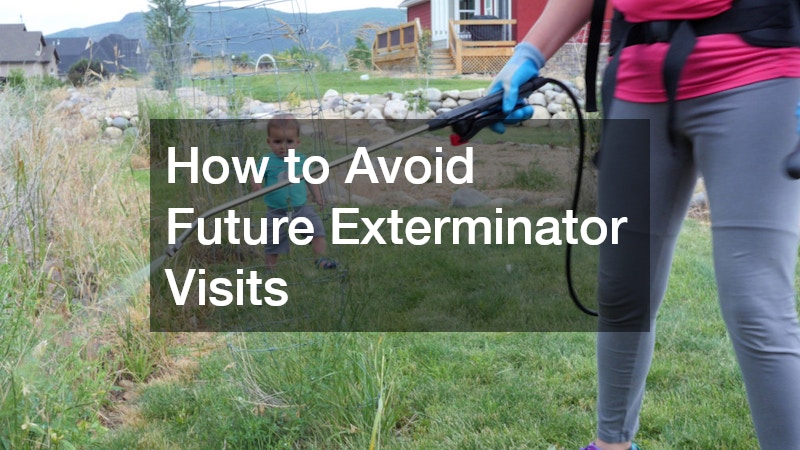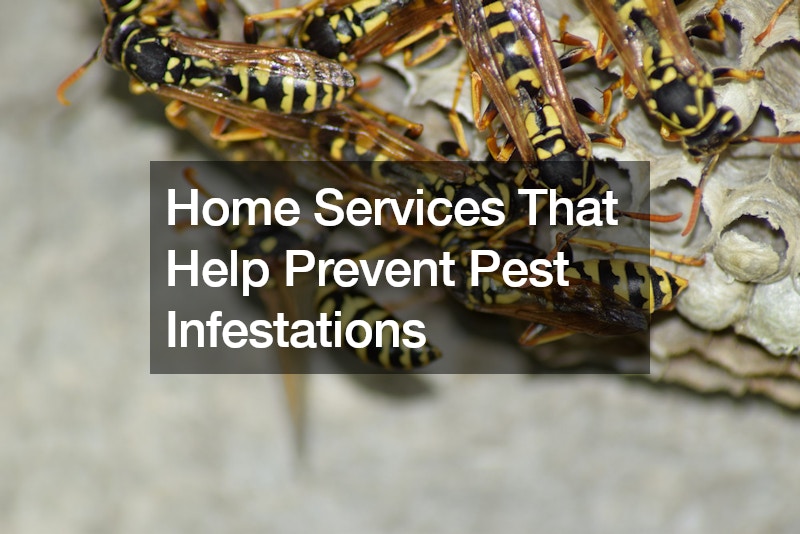Pest infestations disrupt daily life and can cause serious structural and health issues. While exterminators offer reactive solutions, they often come at a high cost and inconvenience. A smarter approach lies in preventing infestations before they happen. By using proactive strategies, homeowners can minimize pest attraction and eliminate points of entry. This article outlines actionable techniques that reduce the risk of infestations, eliminate the need for frequent pest control services, and contribute to a healthier, more secure living environment.
What are the Most Common Pests to Watch Out For?

Understanding Pest Habitats
Pests gravitate toward specific habitats. Rodents seek out dark, undisturbed places like basements and crawl spaces, while insects such as cockroaches and ants prefer moist environments, particularly kitchens and bathrooms. Understanding these habits is essential, especially during new construction or renovation, where unfinished spaces are vulnerable to infestation. Homes with poor ventilation or water damage may even see a combination of pests and mold, requiring both pest control and mold remediation services.
Signs of Pest Infestation
Spotting early signs like droppings, chewed wires, or scratch marks can indicate rodents. Meanwhile, ants often leave scent trails, and termites discard wings near windowsills. Musty odors may point to a mold issue, which can exacerbate pest problems and require immediate mold remediation alongside pest prevention efforts.
Seasons and Pest Activity
Pest activity fluctuates with the seasons. Spring and summer increase insect presence, especially mosquitoes, flies, and ants. The need for mosquito control rises with warmer temperatures and higher humidity, particularly in areas with standing water or dense vegetation. In contrast, fall and winter push rodents indoors in search of warmth, making these seasons critical for pest-proofing.
How Different Pests Impact Your Home
Rodents can chew through electrical wires, increasing the risk of fires, and may even necessitate emergency services from electricians. Termites silently undermine the structural integrity of wooden components, while cockroaches can spread bacteria and allergens. Fleas and ticks, often brought in by pets, are notoriously difficult to eliminate once established. Each type of pest poses unique threats that can compound existing home maintenance issues.
Early Pest Detection Techniques
Technology plays a vital role in early detection. Motion sensors, pest monitoring apps, and even smart thermostats help monitor conditions conducive to infestation. Conduct regular checks in hard-to-reach areas, especially around the screen room, attic, or under sinks where moisture may accumulate, attracting both pests and mold.
How Can I Pest-Proof My Home?
Sealing Entry Points
Cracks, gaps, and vents offer easy access for pests. Use weather stripping on doors and caulk around windows. Spray foam insulation serves a dual purpose—it improves energy efficiency and seals off potential pest entry points. Pay attention to crawl spaces and external connections near plumbing or wiring, as these areas are frequently overlooked.
Maintaining a Clean Environment
A clean home is less attractive to pests. Wipe down countertops, sweep floors, and vacuum regularly to eliminate food crumbs and pet hair. Avoid leaving dirty dishes overnight, especially in homes where appliances are frequently used. Should any device malfunction, timely appliance repair ensures food is stored and prepared in pest-free environments.
Proper Food Storage Solutions
Store pantry items in airtight containers and avoid using original packaging, which pests can easily chew through. Refrigerate fruits and vegetables, and regularly clean storage cabinets to prevent forgotten spills that could attract unwanted guests.
Yard Maintenance and Its Importance
Neglected yards are breeding grounds for pests. Overgrown grass, untrimmed bushes, and fallen leaves offer shelter for rodents and insects. Proper yard drainage is also crucial for mosquito control. A tidy outdoor structure, such as a screen room or gazebo, should be regularly inspected to ensure pests aren’t nesting in hidden corners.
Effective Waste Management Practices
Garbage, compost, and pet waste should be tightly sealed and removed regularly. Compost bins should be elevated and covered, avoiding ingredients like meat or dairy that attract vermin. Integrating waste management with your overall pest control services strategy reduces pest access to food sources.
What Natural Remedies Can Help Prevent Pests?

Essential Oils and Pest Deterrence
Natural oils like peppermint, eucalyptus, and citronella are excellent deterrents. Mix with water to create a spray for baseboards and window sills. Citrus oil also repels spiders and ants, and works well around the kitchen and bathrooms.
Using Herbs as a Defense
Grow herbs such as basil, mint, and lavender near entrances or windows. These plants not only repel insects but also contribute to a fragrant home environment. Placing them near an outdoor structure like a patio or garden shed adds a layer of natural pest defense.
DIY Pest Traps
Homemade traps—such as vinegar and dish soap for fruit flies or sticky traps for roaches—can significantly reduce pest numbers. These options are affordable and non-toxic, making them ideal for homes with children or pets.
Tips for Non-Toxic Pest Control
Use diatomaceous earth in dry, high-traffic pest areas like pantries or behind appliances. This natural powder disrupts the exoskeletons of insects without harming humans or animals. Non-toxic solutions are especially important for homes with allergies or pets.
Effective Use of Natural Repellents
Rotate natural repellents to prevent pests from adapting. Combine multiple methods—such as oils, herbs, and traps—to create a layered approach. A clean and dry environment enhances the effectiveness of these natural solutions.
How Does Regular Maintenance Prevent Future Exterminator Visits?
Scheduled Home Inspections
Set quarterly or seasonal reminders for whole-house inspections. These should include attics, basements, and the perimeter of your screen room or any outdoor structure. Addressing issues early prevents infestations from developing unnoticed.
Recognizing Wear and Tear
Loose siding, broken windows, and damaged door frames are open invitations for pests. Regularly inspect these areas, especially after severe weather or construction projects, and make necessary repairs.
Impact of Timely Repairs
Ignoring a small leak or faulty appliance can escalate into major problems. A plumbing contractor should be consulted for any leak, as water damage can attract termites and foster mold growth. Timely appliance repair also reduces the risk of food contamination from pests.
Benefits of Professional Check-Ups
Beyond DIY efforts, a yearly visit from pest control services can reinforce your prevention strategy. These professionals can spot signs the average homeowner may miss and recommend preventive treatments customized for your environment.
Documenting Maintenance Procedures
Create a digital or physical log of inspections, repairs, and pest control actions. This not only helps track patterns but is valuable documentation for future property sales or insurance claims.
What Role Does Cleanliness Play in Pest Prevention?
Creating Unwelcoming Environments for Pests
Pests thrive in environments rich in food, water, and hiding spots. Daily sanitation disrupts their habitat and makes your home less appealing. Even the area around your outdoor structure should be swept and cleared regularly.
Daily Cleaning Habits to Adopt
Quick tasks like wiping down kitchen counters, sealing food containers, and checking pet bowls help deter pests. Maintain clean surfaces in high-traffic areas and avoid clutter build-up in garages or basements.
The Relationship Between Clutter and Pests
Clutter offers shelter for insects and rodents. Items like cardboard boxes, stacks of newspapers, and unused furniture can harbor pests or mold. Keeping storage areas tidy reduces hiding spots and encourages airflow, which further discourages infestations.
Effective Cleaning Products
Choose enzyme-based cleaners that break down organic materials. For areas prone to mold, mold remediation cleaners offer dual protection. These products are safe for use near pets and children when used correctly.
Deep Cleaning Schedules
Conduct monthly deep cleans behind appliances, inside cabinets, and under furniture. Seasonal efforts should include checking HVAC systems, vents, and areas near spray foam insulation for signs of mold or pest activity.
Can Pets Influence Pest Infestations?

Understanding the Risk Factors
Pets can carry fleas, ticks, and mites indoors, especially after spending time outside. Their bedding, feeding areas, and waste all attract pests, making these spaces crucial for regular cleaning.
Maintaining Pet Areas
Clean litter boxes and feeding stations daily. Use sealed containers for food and dispose of waste promptly. Inspect bedding and soft toys weekly for signs of insect activity.
Protecting Pets from Pests
Flea and tick prevention is essential. Talk to your vet about the best treatments and perform regular inspections. Keep the areas around your outdoor structure or screen room pet-safe and pest-free.
Pest-Resistant Pet Products
Choose beds, toys, and accessories made with pest-repellent fabrics or infused with essential oils. Many modern products also feature antimicrobial and mold-resistant properties, adding another layer of protection.
Monitoring Pets for Signs of Pests
Frequent scratching, visible bites, or skin irritations may indicate pests. Early detection prevents infestation in both your pet and your home, avoiding the need for pest control services down the line.
How Does Landscaping Affect Pest Control?
Choosing Pest-Resistant Plants
Certain plants repel pests naturally. Marigolds deter mosquitoes and aphids, while lemongrass and citronella are effective for mosquito control. Place these strategically around your outdoor structures to create a natural barrier.
Proper Yard Drainage
Eliminate standing water in birdbaths, pots, and gutters to reduce mosquito breeding. If drainage is an issue, consult with a landscaping expert or plumbing contractor to design a more efficient system.
Benefits of a Tidy Garden
A well-maintained garden reduces shelter for rodents and insects. Remove fallen fruit, dead leaves, and compost regularly. Trim shrubs and trees to prevent pests from using them as bridges to your roof or attic.
Understanding Plant-Pest Relationships
Not all insects are harmful. Attract beneficial species like ladybugs and praying mantises to manage pest populations naturally. Balanced ecosystems are more resilient against invasions.
Mulching, Composting, and Pest Prevention
Use mulch sparingly and keep it away from your home’s foundation. Covered compost bins reduce exposure and prevent rodents. Spray foam insulation around your foundation also prevents pests from entering through small cracks.
What Are the Benefits of Professional Pest Advice?
Consultation for Prevention
Professionals assess your home’s unique vulnerabilities and provide targeted advice. Whether it’s a newly built property or a decades-old home, pest control services offer guidance suited to your specific needs.
Understanding Pest Behavior
Experts have in-depth knowledge of pest life cycles, seasonal habits, and common hiding spots. This insight helps you make smarter decisions about your home’s maintenance and cleanliness.
Tailored Pest Control Plans
Customized prevention plans may include scheduled treatments, natural deterrents, or moisture control. These are particularly useful during or after new construction, where preventative measures can be built into the design.
Updates on Latest Pest Control Innovations
Professionals stay updated on cutting-edge methods, from thermal imaging for termite detection to eco-friendly pesticides. These innovations improve efficiency and reduce environmental impact.
Building a Long-Term Pest Prevention Strategy
Long-term success relies on ongoing attention. A pest control plan that includes seasonal inspections, structural assessments, and updates to your prevention strategy ensures continuous protection.
How Can Technology Aid in Preventing Pest Infestations?
Smart Home Systems for Pest Detection
Sensors that detect motion, moisture, or heat changes can alert homeowners to potential infestations. Integrate these systems into high-risk areas like basements, attics, or near your screen room for better monitoring.
Using Pest Monitoring Apps
Track pest sightings, schedule cleanings, and log inspections with user-friendly apps. Many also include databases for identifying pests and suggesting prevention techniques.
Automated Pest Control Solutions
Ultrasonic repellents, automatic traps, and scent diffusers provide passive protection. These systems can be particularly useful in rarely accessed areas like attics, garages, or behind outdoor structures.
Integrating Technology in Home Design
Modern homes can integrate pest-resistant materials and monitoring devices from the outset. For example, choosing mold-resistant drywall and spray foam insulation reduces both moisture retention and pest entry points.
Pros and Cons of Tech-Assisted Pest Management
While tech solutions add convenience, they are not foolproof. Manual inspections and professional advice remain essential. A hybrid approach often yields the best results.
Are There Community Approaches to Pest Prevention?

Neighborhood Watch for Pests
Just like crime watch programs, neighborhoods can unite against pests. Sharing information about local infestations helps everyone act quickly and effectively.
Community Pest Management Programs
Many municipalities offer subsidized pest control services or neighborhood-wide treatments. Participation helps reduce overall pest populations in the area.
Sharing Resources and Knowledge
Neighborhood forums, gardening clubs, and online groups are excellent venues for exchanging prevention tips and local vendor recommendations, including electricians and plumbing contractors who may notice pest-related issues during their work.
Community Clean-Up Initiatives
Group clean-ups not only improve aesthetics but also eliminate hiding places and food sources for pests. Organizing regular events builds awareness and strengthens community bonds.
Advocating for Pesticide Regulations
Communities can lobby for safer pest control policies, promoting non-toxic solutions and regulating commercial pesticide usage. This leads to more sustainable and health-conscious practices.
Final Thoughts
Preventing pest infestations requires a comprehensive approach that blends daily habits, home maintenance, natural remedies, and technological tools. From cleaning routines and landscaping choices to professional consultations and community involvement, every effort contributes to a safer, pest-free environment. When prevention becomes part of your lifestyle and home care plan, future exterminator visits can become the exception rather than the rule.



